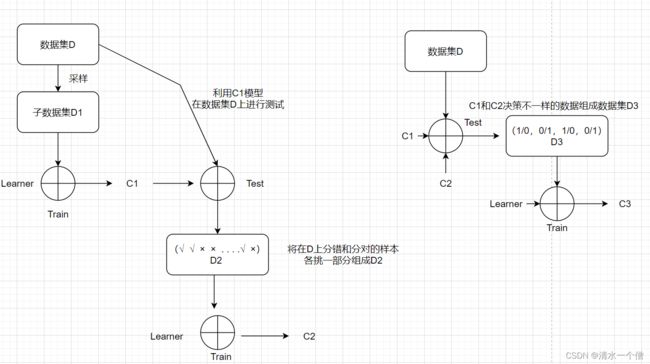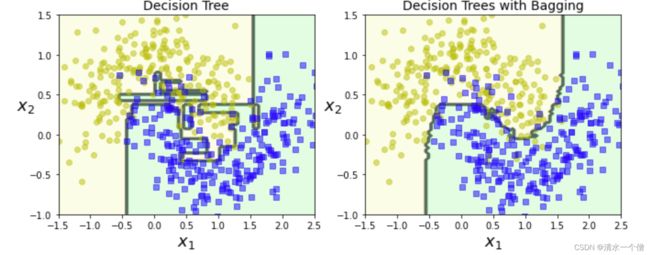机器学习实战(集成学习)
集成学习简介
集成学习的核心是如何产生并结合“好而不同”的个体学习器
根据个体学习器的生成方式,目前的集成学习方法大致分为两大类
- 个体学习器间存在强依赖关系,必须串行生成的序列化方法(Boosting)
- 个体学习器之间不存在强依赖关系、可同时生成的并行方法(Bagging和随机森林Random Frost)
Bagging与随机森林
Bagging基于有放回的采样(自助采样法),基本流程为:将训练集进行采样,每个子训练集中含有m个样本,生成k个子训练集,因为是又放回的采样,所以训练集中的数据并不是全部出现在子训练集中,初始训练集约有63.2%出现在子训练集中。随机选取一个基学习器,将这些样本分别在这个学习器上进行学习,因为每个子训练集的样本都是不同的,所以用这些训练集训练生成的学习器也是不同的,这样最终就得到K个不同的学习器,将初始训练集中没有被采样的36.8%的数据用作验证集,在产生的K个学习器上分别进行验证,K个学习器分别给出自己的结论,最终以‘少数服从多数’的准则输出最终结果。
随机森林和Bagging的步骤类似。
随机森林为了能够训练出不同的决策树,采用的策略为:
- 用自助采样法生成子集
- 每一棵树使用的属性可能不同
Boosting
Boosting是一族可以将弱学习器提升为强学习器的方法(基学习器的成功率>50%,结果产生的学习器成功率就会很高)。
Boosting是一种串行的方法,基本的思想是当数据分错时,提高其权重,在以后的学习中突出其重要性。基本的流程为:
Boosting的决策流程为:
AdaBoost算法是Boosting的代表算法,AdaBoost算法指定了权重更新的准则。
Sklearn实现集成学习
下面的代码用Scikit-Learn创建并训练一个投票分类器,由三种不同的分类器组成
from sklearn.model_selection import train_test_split
from sklearn.datasets import make_moons
X, y = make_moons(n_samples=500, noise=0.30, random_state=42)
X_train, X_test, y_train, y_test = train_test_split(X, y, random_state=42)
from sklearn.ensemble import RandomForestClassifier
from sklearn.ensemble import VotingClassifier
from sklearn.linear_model import LogisticRegression
from sklearn.svm import SVC
log_clf = LogisticRegression(solver="liblinear", random_state=42)
rnd_clf = RandomForestClassifier(n_estimators=10, random_state=42)
svm_clf = SVC(gamma="auto", random_state=42)
voting_clf = VotingClassifier(
estimators=[('lr', log_clf), ("rf", rnd_clf), ("svc", svm_clf)],
voting="hard"
)
voting_clf.fit(X_train, y_train)
from sklearn.metrics import accuracy_score
for clf in (log_clf, rnd_clf, svm_clf, voting_clf):
clf.fit(X_train, y_train)
y_pred = clf.predict(X_test)
print(clf.__class__.__name__, accuracy_score(y_test, y_pred))训练了一个包含500个决策树分类器的集成,每次随机从训练集中采样100个训练实例进行训练,然后放回。
from sklearn.ensemble import BaggingClassifier
from sklearn.tree import DecisionTreeClassifier
bag_clf = BaggingClassifier(
DecisionTreeClassifier(random_state=42), n_estimators=500,
max_samples=100, bootstrap=True, n_jobs=-1, random_state=42)
bag_clf.fit(X_train, y_train)
y_pred = bag_clf.predict(X_test)
from sklearn.metrics import accuracy_score
print(accuracy_score(y_test, y_pred))
单个决策树:
tree_clf = DecisionTreeClassifier(random_state=42)
tree_clf.fit(X_train, y_train)
y_pred_tree = tree_clf.predict(X_test)
print(accuracy_score(y_test, y_pred_tree))结果比较:
from matplotlib.colors import ListedColormap
def plot_decision_boundary(clf, X, y, axes=[-1.5, 2.5, -1, 1.5], alpha=0.5, contour=True):
x1s = np.linspace(axes[0], axes[1], 100)
x2s = np.linspace(axes[2], axes[3], 100)
x1, x2 = np.meshgrid(x1s, x2s)
X_new = np.c_[x1.ravel(), x2.ravel()]
y_pred = clf.predict(X_new).reshape(x1.shape)
custom_cmap = ListedColormap(['#fafab0','#9898ff','#a0faa0'])
plt.contourf(x1, x2, y_pred, alpha=0.3, cmap=custom_cmap)
if contour:
custom_cmap2 = ListedColormap(['#7d7d58','#4c4c7f','#507d50'])
plt.contour(x1, x2, y_pred, cmap=custom_cmap2, alpha=0.8)
plt.plot(X[:, 0][y==0], X[:, 1][y==0], "yo", alpha=alpha)
plt.plot(X[:, 0][y==1], X[:, 1][y==1], "bs", alpha=alpha)
plt.axis(axes)
plt.xlabel(r"$x_1$", fontsize=18)
plt.ylabel(r"$x_2$", fontsize=18, rotation=0)
plt.figure(figsize=(11,4))
plt.subplot(121)
plot_decision_boundary(tree_clf, X, y)
plt.title("Decision Tree", fontsize=14)
plt.subplot(122)
plot_decision_boundary(bag_clf, X, y)
plt.title("Decision Trees with Bagging", fontsize=14)
save_fig("decision_tree_without_and_with_bagging_plot")



